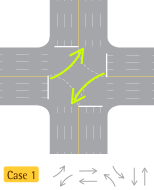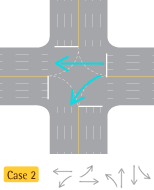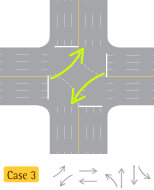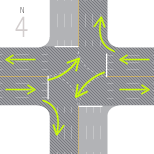 |
 |
| |
- The TLSI takes the conventional intersection and its 4 signals into a 2-level intersection and separate the signals into 2-phase signals for each of the top and bottom roads of the intersection. - Since the traffic signals are processed independently for the top and the bottom roads of the intersection, the duration of the green light is more than doubled. - The top and bottom signal systems function independently and are not affected by each other. - Application of ITS (Intelligent Transport System) would result in better synergy than the conventional intersection. |
|||||
 |
|||||
| - The conventional intersection utilizes the following combination
of signals: |
|||||
| Case
1 : Dual left turn signals, and dual straight
through signals Case 2 : Vehicles entering the intersection from all four directions utilize straight through and left turn signals. Case 3 : Combination of Case 1 and Case 2. |
|||||
|
|||||
 |
|||||
| - Let’s take a look at the road utilized by vehicles entering intersection from east and west versus north and south in a typical conventional intersection. | |||||
|
|||||
| - Vehicles can choose from four directions of travel, namely, left
turn, straight through, right turn and U-turn. |
|||||
| - |
|||||
| - |
|||||
| - Developed by Roadnext, the TLSI puts Diagram 1 on top of Diagram 2 to make a two-level intersection from a conventional intersection. | |||||
 |
|||||
| - As such TLSI utilizes different sets of signal system for the top and the bottom part of the intersection. In other words, north-south traffic is controlled with one signal system on the bottom parts of the intersection, while east-west traffic is controlled with another signal system on the top part of the intersection. | |||||
| - The number of signal systems used is two for the top and two for the bottom part of the intersection. | |||||
- As such, the top part and the bottom part of the intersection are of the same structure, and the directions of travel are identical to the conventional intersection. (Left turns are made from the left lane, and right turns are made from the right lane.) |
|||||
- This is partially identical to the top part of SPUI (Single-Point Urban Interchange). For more details, please click on Overview II. |
|||||
 |




